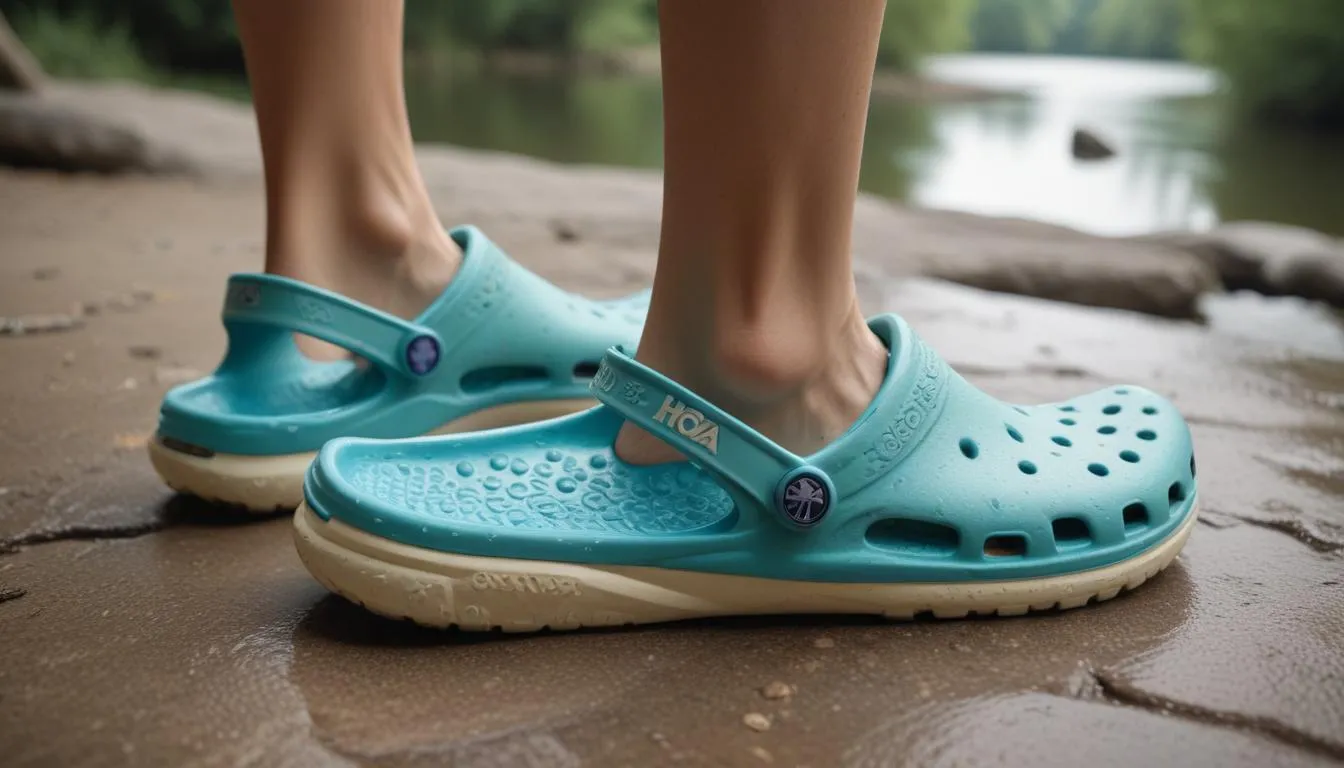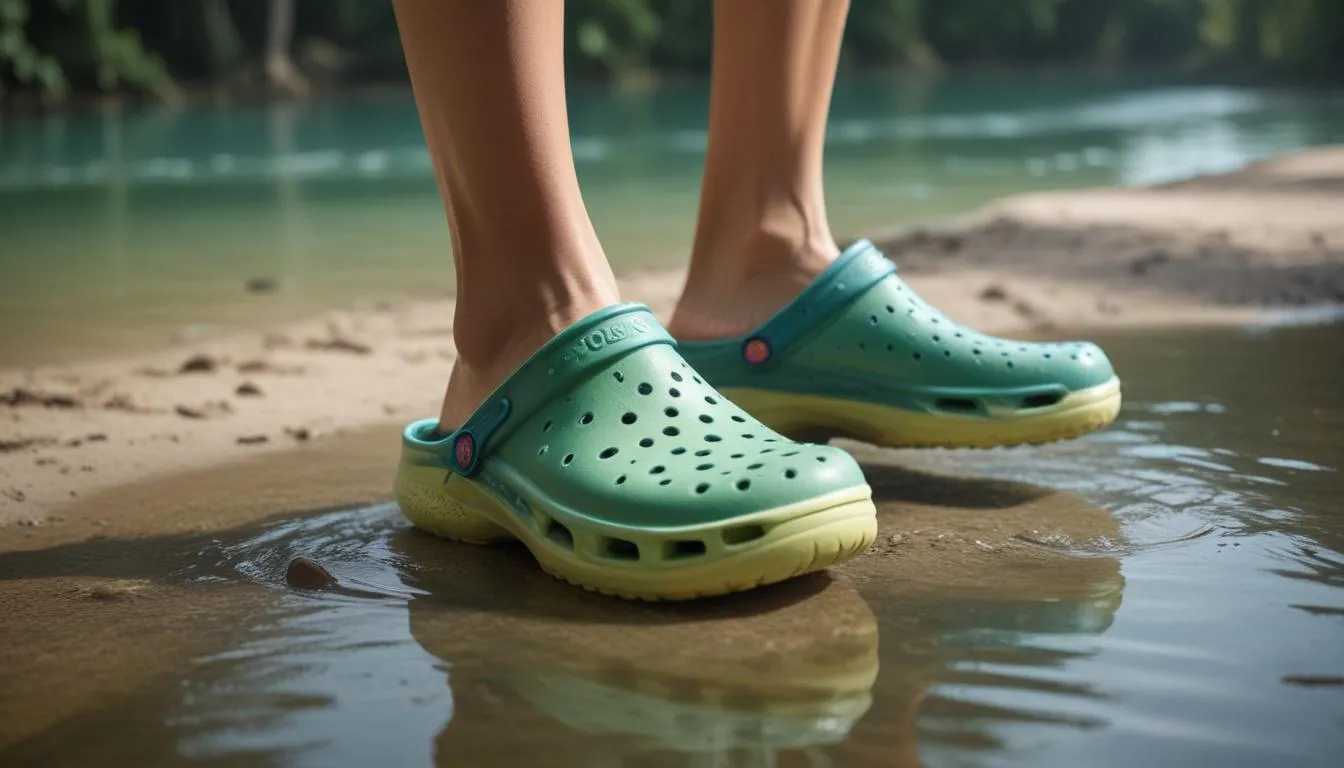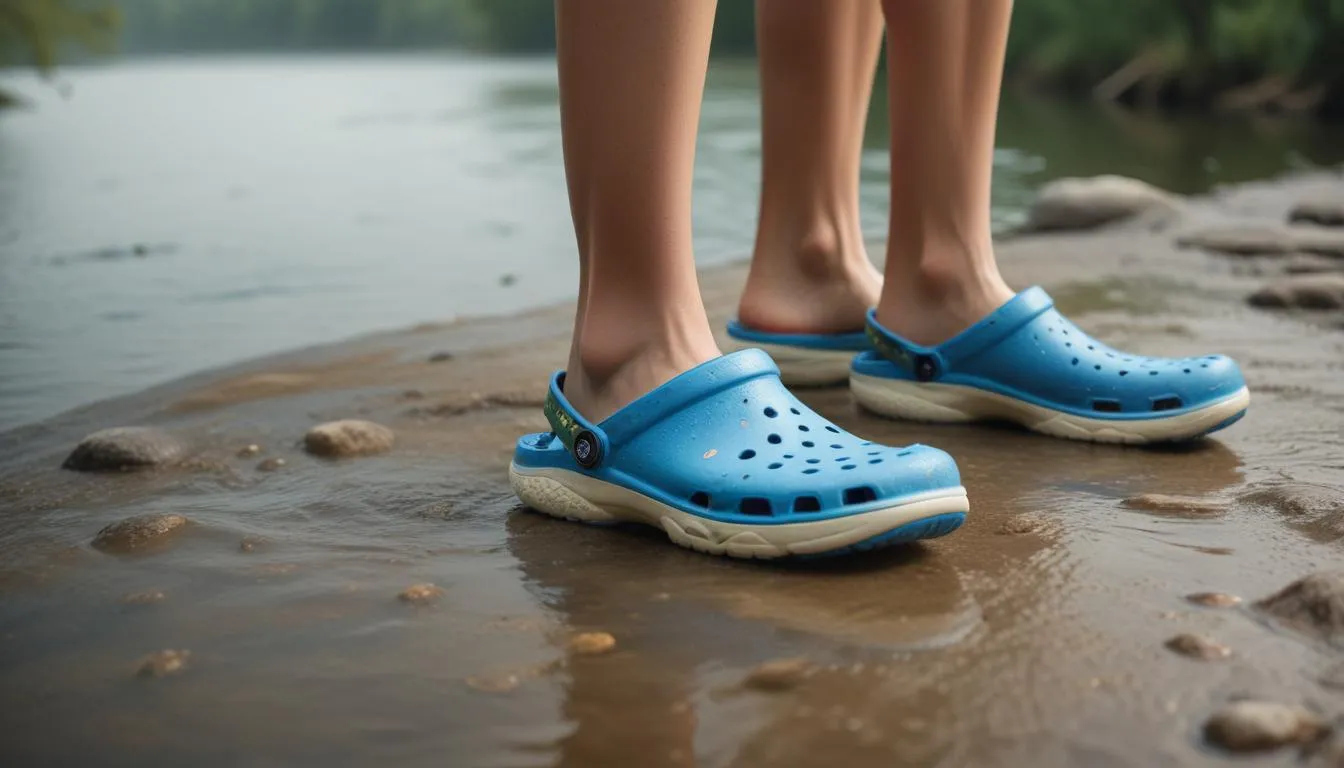When it comes to comfort, both Crocs and Hoka footwear offer unique experiences. Crocs are known for their soft, cushioned footbeds. They provide a light bounce with every step. This makes them feel great for casual wear. Hoka, on the other hand, provides a higher level of cushioning. Their maximum cushioning design absorbs impact effectively. You will often feel like you are walking on clouds in Hoka shoes.
I encourage you to try both types for a firsthand experience. Crocs typically fit snugly around your foot. This ensures a secure feel during wear. Hoka shoes tend to have a wider toe box. This prevents crowding and allows your toes to spread comfortably. Many users appreciate this feature during long walks or runs.
To summarize comfort levels, here is a comparison:
| Brand | Cushioning | Fit | Recommended Use |
|---|---|---|---|
| Crocs | Soft, lightweight | Snug | Casual wear, short walks |
| Hoka | Maximum cushioning | Wider toe box | Running, long walks |
Many people find Crocs ideal for quick errands. Their easy slip-on design adds to the comfort. Hoka shoes shine during prolonged physical activities. You can go for longer distances without discomfort. In terms of comfort, your personal preference will play a large role.
Design and Style Comparisons
When looking at design and style, Crocs and Hoka have different aesthetics. Crocs typically offer a playful and colorful look. They come in various shades and patterns. This makes them appealing to a wide audience, from children to adults. Hoka, in contrast, focuses on a more athletic and streamlined design. Their shoes often feature sleek lines and a performance-oriented appearance.
You might prefer Crocs for their fun and versatile styles. Many people enjoy customizing them with Jibbitz charms. This adds a personal touch to the footwear. Hoka’s designs, however, are meant to be functional and sporty. They present a more serious vibe for those who prioritize performance.
Here’s a quick comparison of style features:
| Brand | Aesthetic | Customization | Intended Audience |
|---|---|---|---|
| Crocs | Playful, colorful | High (Jibbitz charms) | All ages |
| Hoka | Sleek, athletic | Low | Active individuals |
Crocs provide a more casual style. You can wear them at home or at the beach. Hoka shoes are better suited for outdoor activities and workouts. Their designs often reflect a commitment to running and fitness. Depending on your lifestyle, one may stand out over the other.
The choice between the two also depends on how you wish to express yourself. Crocs encourage creativity through fun designs. Hoka promotes a serious approach to fitness through their sporty look. Both brands cater to distinct tastes within their markets.
Material Analysis: What Are They Made Of?
When examining the materials used in Crocs and Hoka, you’ll notice significant differences. Crocs primarily utilize a patented closed-cell resin known as Croslite. This material is lightweight, buoyant, and resistant to odor. It contributes to the comfort and ease of cleaning. Additionally, this material allows for breathability, making Crocs suitable for warm weather.
Hoka, on the other hand, employs various textiles and foams in their construction. The upper portion often features mesh or engineered materials. These allow for ventilation while maintaining structural integrity. Hoka’s midsoles are crafted from EVA foam, known for its excellent cushioning and shock absorption properties.
Let’s look at a detailed comparison of the materials:
| Brand | Main Material | Weight | Breathability |
|---|---|---|---|
| Crocs | Croslite (closed-cell resin) | Very lightweight | Highly breathable |
| Hoka | EVA foam, mesh/textiles | Moderately lightweight | Good ventilation |
The unique materials contribute to the overall user experience. Crocs are easy to maintain, simply needing a rinse or wipe after use. Hoka shoes often require more careful handling due to their textile components. You can enjoy a comfortable fit with both, but the cleaning process varies.
Another aspect to consider is odor resistance. Crocs naturally inhibit odors, thanks to the properties of Croslite. This is especially useful during summer months. In contrast, Hoka’s materials may require regular washing to prevent odors. This is particularly relevant for users engaging in high-intensity activities.
<pChoosing between Crocs and Hoka based on material depends on your lifestyle. Crocs excel in casual, everyday use with easy maintenance. Hoka is geared toward performance and support during athletic activities. Both brands showcase innovative use of materials that meet distinct consumer needs.
Foot Support and Ergonomics

Foot support and ergonomics play a vital role in the overall comfort of footwear. Crocs are designed to offer good arch support and a cushioned footbed. Their unique design cradles your foot while allowing for flexibility. This ensures a comfortable fit during everyday activities. Many wearers report reduced fatigue when standing for extended periods in Crocs.
On the other hand, Hoka is renowned for its advanced cushioning technology. Their shoes provide exceptional shock absorption. This is particularly beneficial for runners and those engaging in prolonged physical activities. Hoka’s wide base enhances stability and lends additional support to the foot. Users often emphasize how this design helps prevent injuries during longer runs or hikes.
Comparing foot support attributes, we can summarize the key features:
| Brand | Arch Support | Cushioning | Best for |
|---|---|---|---|
| Crocs | Moderate | Cushioned footbed | Casual wear, standing |
| Hoka | High | Maximum cushioning | Running, hiking |
When considering ergonomics, Crocs feature a lightweight design that reduces overall foot strain. They also offer a breathable structure, which helps maintain comfort during warmer days. Hoka shoes, in contrast, incorporate anatomical shapes to promote natural foot movement. Their wide toe box allows for toe splay, significantly improving comfort over extended periods.
<pBoth brands have their own strengths in foot support and ergonomics. If you prioritize casual, everyday comfort, Crocs are a great choice. However, for serious athletes or those frequently on their feet, Hoka's specialized design offers superior support. Your individual needs and activities will guide your best choice in footwear.
Traction and Durability
Traction and durability are crucial considerations when choosing slides or casual footwear. Crocs are designed with a proprietary tread pattern. This provides decent grip on various surfaces. The material is non-marking, which prevents scuffing inside your home. However, you may find that they lack traction on wet or slippery surfaces.
In contrast, Hoka shoes feature advanced outsole technology. Their rubber outsoles often include traction-enhancing lugs. This is especially helpful for outdoor activities like hiking or running. Many users report feeling secure even on uneven terrain. Additionally, Hoka shoes tend to exhibit higher durability against wear and tear.
Here’s a detailed look at the traction and durability aspects:
| Brand | Tread Design | Material Durability | Best Surface Usage |
|---|---|---|---|
| Crocs | Basic tread pattern | Moderate | Dry, flat surfaces |
| Hoka | Advanced traction lugs | High | Uneven, wet, and dry surfaces |
<pWhile Crocs may serve well for casual use around the home or beach, they may not perform optimally in rugged conditions. Hoka shoes are engineered for more dynamic environments. Users often comment on the stability and support provided by Hoka's traction system.
<pDurability is another strong point for Hoka. These shoes are built to withstand the demands of an active lifestyle. You can expect a longer lifespan compared to Crocs, which may show signs of wear over time. Hoka's materials resist abrasions effectively, making them suitable for outdoor adventures.
<pUltimately, your choice should depend on your typical activities. If you mostly need slides for indoor or light outdoor use, Crocs will suffice. For users engaged in outdoor sports or rugged terrain, Hoka offers better traction and longer-lasting durability. Both brands cater to different priorities, so consider your lifestyle when making a decision.
Weight and Portability
When considering weight and portability, both Crocs and Hoka have distinct characteristics that cater to different needs. Crocs are exceptionally lightweight, making them easy to wear for extended periods. You can easily slip them into your bag for a weekend getaway or a day at the beach. Their buoyancy is a significant advantage, especially when traveling or walking for leisure.
Hoka shoes, while designed for performance, are somewhat heavier compared to Crocs. The extra weight comes from the maximum cushioning and supportive structure they offer. However, many users find the additional weight justified, given the comfort and support provided during long runs or hikes. The weight of Hoka shoes can still be manageable for casual wear, but not as optimal for quick errand runs.
| Brand | Weight | Portability | Best Uses |
|---|---|---|---|
| Crocs | Very lightweight | Highly portable | Casual, travel |
| Hoka | Moderately lightweight | Moderately portable | Running, hiking |
<pCrocs truly excel in portability due to their ease of packing and wearing. You can fold or crush them slightly without compromising their shape. This makes them a favorite choice for campers or beachgoers who prioritize convenience. Hoka shoes, while slightly bulkier, are still comfortable enough to wear throughout the day. Users appreciate their ability to perform effectively during physical activities.
<pIf you prioritize weight for daily tasks, Crocs are hard to beat. Their design allows you to move freely without dragging your feet. Hoka’s focus is more on providing exceptional support and cushioning. While they might weigh a bit more, this is balanced with enhanced performance features.
<pUltimately, the choice between the two will depend on your activities. For casual or travel-oriented needs, Crocs are a fantastic fit. If your focus leans toward athletic performance, Hoka delivers on support even if it means carrying a little extra weight.
Pricing and Value for Money
When comparing the pricing and value for money of Crocs and Hoka footwear, you’ll find notable differences. Crocs are generally more affordable. Their price range usually falls between $30 and $70, making them a budget-friendly option. You can find a variety of colors and styles within this range. This accessibility makes Crocs a popular choice for casual wear.
In contrast, Hoka slides and shoes tend to be on the higher end. Prices typically range from $100 to $200. While this may seem steep, many users justify the cost due to the quality and performance. Hoka products are engineered for maximum comfort, durability, and support. This makes them a worthwhile investment for individuals who lead active lifestyles.
Here’s a detailed price comparison:
| Brand | Average Price Range | Material Quality | Longevity |
|---|---|---|---|
| Crocs | $30 – $70 | Moderate | 2 – 5 years |
| Hoka | $100 – $200 | High | 3 – 7 years |
<pIn terms of material quality, Crocs use the Croslite material, known for its lightweight properties but moderate durability. Hoka, on the other hand, uses high-quality EVA foam and durable textiles. This contributes to their longer lifespan and superior performance for physical activities. Many users find that Hoka shoes withstand more wear and tear over time, ultimately providing better value for their investment.
<pIt's also important to consider how often you plan to use the footwear. If you're looking for everyday casual shoes, Crocs present excellent value. However, if you engage in regular running or intense workouts, the price of Hoka may be justified with the performance benefits. Your overall satisfaction with either brand will hinge on how well they meet your specific footwear needs.
<pWhether you opt for budget-friendly Crocs or invest in Hoka's premium design, each brand caters to different consumer needs. Your personal usage patterns and priorities will dictate the best choice for you, ensuring that you get the best value for your money.
Customer Reviews and Experiences

Customer feedback plays a significant role in understanding the differences between Crocs and Hoka. Users have shared various experiences based on their footwear preferences. For Crocs, many appreciate the convenience of slip-on design. People often mention how easy they are to wear around the house or for short errands. The lightweight nature and comfort level have garnered positive remarks from casual wearers.
However, some users have noted that Crocs may lack sufficient support for extended outdoor use. Individuals have reported discomfort during long walks, particularly on uneven surfaces. It’s essential to consider your primary use when evaluating Crocs for daily wear. If you require versatile footwear for quick tasks, Crocs are often recommended.
Comparatively, Hoka users often rave about the exceptional comfort levels during high-intensity activities. Runners specifically praise Hoka’s maximum cushioning for absorbing impact. Many athletes have shared experiences stating that Hoka significantly reduces fatigue during long runs. They often feel a difference in energy levels compared to other brands, especially after longer sessions.
On the downside, some users have pointed out the weight of Hoka shoes. They mention that Hoka shoes can feel bulkier compared to lighter alternatives. This may deter casual wearers looking for something easy to slip on. Combining experiences from various individuals gives insight into both brands’ strengths and weaknesses.
| Brand | User Experience | Common Praises | Common Complaints |
|---|---|---|---|
| Crocs | Casual wearers, quick errands | Lightweight, easy to wear | Lack of support for long walks |
| Hoka | Runners, active individuals | Exceptional cushioning, fatigue reduction | Bulkier than casual alternatives |
<pOverall, both brands cater to specific needs. Crocs excel in home and casual environments, while Hoka serves those engaged in athletic pursuits. Understanding individual experiences can guide you in making an informed decision. When purchasing, consider how you plan to use the footwear to find the best match for your lifestyle.
Best Use Cases for Each Brand
When determining the best use cases for Crocs and Hoka, it’s essential to consider the environments and activities in which each brand shines. Crocs are incredibly versatile for everyday wear. They are perfect for quick errands, lounging around the house, or casual outings. Their slip-on design makes them easy to wear, and they are lightweight enough for short trips. You can easily wear them on a walk to the mailbox or during a beach day.
For gardening or light outdoor activities, Crocs provide comfort and convenience. Their water-resistant material allows you to get them dirty, rinse them off, and continue wearing them. Moreover, many people enjoy using Crocs as poolside footwear because they dry quickly and are not slippery when wet. With a plethora of fun colors and customizable charms, you can express yourself while enjoying relaxation time.
In contrast, Hoka shoes excel in more demanding environments. If you are a runner or enjoy hiking, Hoka provides the support needed for prolonged activity. Their design focuses on performance, making them ideal for long-distance running and strenuous exercises. You can count on their excellent cushioning to absorb shock and help prevent fatigue during those challenging workouts.
<pMoreover, Hoka's robust traction makes them well-suited for various terrains. If you plan to hike on uneven ground, Hoka shoes will ensure stability and confidence with each step. Many avid walkers also appreciate integrating Hoka into their routine due to the exceptional comfort and support they provide.
| Brand | Best Use Cases | Recommended Activities | Ideal Environments |
|---|---|---|---|
| Crocs | Casual wear, home use | Short errands, beach visits, gardening | Warm weather, indoors, light outdoor |
| Hoka | Athletic use, outdoor activities | Running, hiking, extended walks | Trail, uneven terrain, wet conditions |
<pUltimately, understanding where and how each brand excels can help you make a more informed decision. Choose Crocs for relaxed, informal activities where ease and comfort are paramount. Opt for Hoka when support, performance, and durability are required for more rigorous physical pursuits. Aligning your footwear choice with your lifestyle will lead to optimum satisfaction.
Final Verdict: Which is Better?
In the final assessment of Crocs versus Hoka, the decision largely depends on your specific needs and lifestyle. Crocs stand out for their affordability and ease of use. They are lightweight and versatile, suitable for casual wear and quick errands. Their playful designs and customizable features are appealing, especially for those looking for comfortable at-home footwear. If you prioritize convenience and style at a lower price point, Crocs will likely serve you well.
On the other hand, Hoka offers superior performance for active individuals. Their advanced cushioning and ergonomic design make them ideal for running and outdoor activities. Users consistently report reduced fatigue and enhanced comfort during extended workouts. While Hoka shoes come with a higher price tag, the investment can be worth it for regular athletes and outdoor enthusiasts seeking top-tier support and durability.
Here’s a summarised comparison of key factors influencing your choice:
| Brand | Affordability | Performance | Best For |
|---|---|---|---|
| Crocs | Low | Moderate | Casual use, everyday wear |
| Hoka | High | Exceptional | Athletic use, serious workouts |
<pUltimately, your choice should reflect your daily activities and preferences. If you're looking for a fun, light option for short outings, Crocs may be your best fit. Conversely, if your routine includes running or hiking, investing in Hoka could enhance your comfort and performance. By assessing your priorities, you can confidently select the brand that will best meet your footwear needs.
